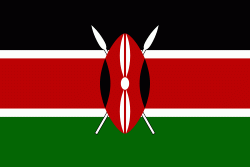Moi International Airport (Mombasa Airport)
Moi International Airport is an international airport in Mombasa, the second-largest city in Kenya. In 2020, the airport was heralded as the "Best Airport in Africa" (with under 2 million passengers annually) by Airports Council International.
Moi International Airport serves the city of Mombasa and surrounding communities. It lies approximately 425 km, by air, southeast of Jomo Kenyatta International Airport, the largest and busiest airport in the country. Mombasa Airport is operated by Kenya Airports Authority. It was named after former Kenyan President Daniel arap Moi during his tenure.
At 61 m above sea level, the airport has two runways: Runway 1 measures 3350 m in length and Runway 2 measures 1260 m in length. Runway 1 is also known as Runway 03/21, while Runway 2 is also known as Runway 15/33. Runway 1 is equipped with an ILS (Instrument Landing System).
There are two terminals at the airport. Terminal 1 is primarily used for international flights, while Terminal 2 is used for domestic flights. Some airlines such as Kenya Airways use Terminal 1 for both domestic and international.
In September 2018, it was confirmed that Qatar Airways would be introducing four weekly flights to Mombasa operating with the A320. The first flight commenced on 11 December 2018, with a flight time from Doha of just over 6 hours.
Moi International Airport serves the city of Mombasa and surrounding communities. It lies approximately 425 km, by air, southeast of Jomo Kenyatta International Airport, the largest and busiest airport in the country. Mombasa Airport is operated by Kenya Airports Authority. It was named after former Kenyan President Daniel arap Moi during his tenure.
At 61 m above sea level, the airport has two runways: Runway 1 measures 3350 m in length and Runway 2 measures 1260 m in length. Runway 1 is also known as Runway 03/21, while Runway 2 is also known as Runway 15/33. Runway 1 is equipped with an ILS (Instrument Landing System).
There are two terminals at the airport. Terminal 1 is primarily used for international flights, while Terminal 2 is used for domestic flights. Some airlines such as Kenya Airways use Terminal 1 for both domestic and international.
In September 2018, it was confirmed that Qatar Airways would be introducing four weekly flights to Mombasa operating with the A320. The first flight commenced on 11 December 2018, with a flight time from Doha of just over 6 hours.
| IATA Code | MBA | ICAO Code | HKMO | FAA Code | |
|---|---|---|---|---|---|
| Telephone | Fax | ||||
| Home page | Hyperlink |
Map - Moi International Airport (Mombasa Airport)
Map
Country - Kenya
 |
 |
| Flag of Kenya | |
Kenya's earliest inhabitants were hunter-gatherers, like the present-day Hadza people. According to archaeological dating of associated artifacts and skeletal material, Cushitic speakers first settled in Kenya's lowlands between 3,200 and 1,300 BC, a phase known as the Lowland Savanna Pastoral Neolithic. Nilotic-speaking pastoralists (ancestral to Kenya's Nilotic speakers) began migrating from present-day South Sudan into Kenya around 500 BC. Bantu people settled at the coast and the interior between 250 BC and 500 AD. European contact began in 1500 AD with the Portuguese Empire, and effective colonisation of Kenya began in the 19th century during the European exploration of the interior. Modern-day Kenya emerged from a protectorate established by the British Empire in 1895 and the subsequent Kenya Colony, which began in 1920. Numerous disputes between the UK and the colony led to the Mau Mau revolution, which began in 1952, and the declaration of independence in 1963. After independence, Kenya remained a member of the Commonwealth of Nations. The current constitution was adopted in 2010 and replaced the 1963 independence constitution.
Currency / Language
| ISO | Currency | Symbol | Significant figures |
|---|---|---|---|
| KES | Kenyan shilling | Sh | 2 |
| ISO | Language |
|---|---|
| EN | English language |
| SW | Swahili language |















